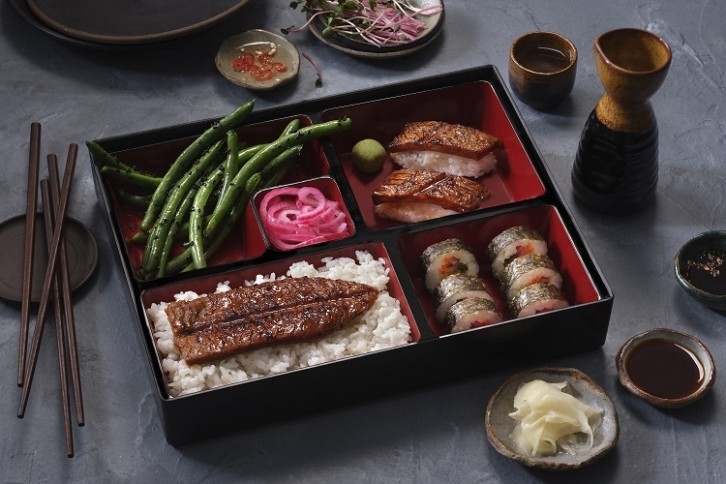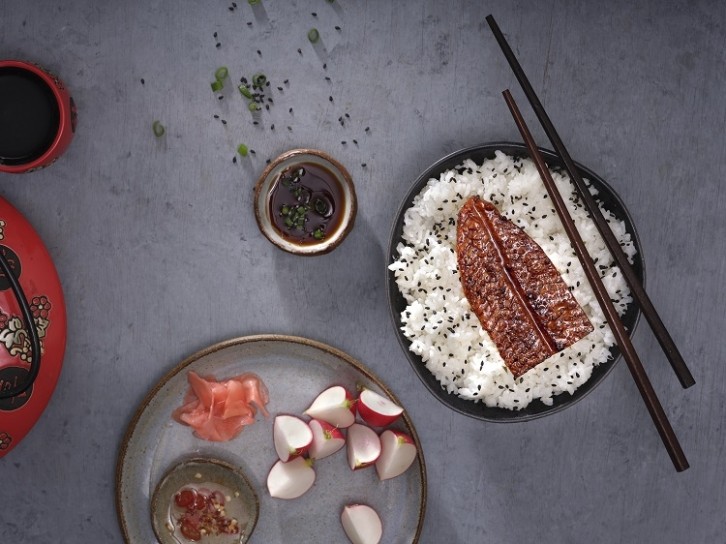Cultured meat expertise, whereby real animal meat is produced by cultivating animal cells, has largely centered on land-based species so far. Of the three corporations which have to date achieved regulatory approval (in Singapore, the US and Israel), two make cultivated hen, and one, beef.
However more and more, innovators are turning to the world’s oceans and freshwater sources for inspiration. In labs all over the world, one can discover cultivated tilapia, scallops and fish fingers in growth, and in Israel, cultivated eel.
At the moment (22 January), Israeli start-up Forsea Meals has introduced a working proof-of-concept that it claims embodies the sensory attributes of actual eel meat.
“Now we have been working internally with our companions at [Tokyo restaurant] SAIDO to develop a product that carefully resembles the standard one,” Forsea co-founder and CEO Roee Nir informed FoodNavigator. “We managed to realize this by making use of meals science practices on eel cells we grew in our lab.”
Organoid expertise cuts progress issue invoice
Japanese unagi eel (Anguilla japonica) is a basic of the native delicacies. Eel meat has a ‘very distinguished’ flavour and texture, which Nir defined will not be corresponding to every other kind of fish.
“It’s a fatty fish with a novel, wealthy complicated flavour. The feel of eel could be very tender and it feels as if it virtually melts in your mouth.”
To copy the feel and flavour of unagi eel, Forsea has turned to organoid expertise – its proprietary technique for crafting 3D microtissues composed of fats and muscle. As an alternative of rising animal cells in bioreactors, Forsea creates the ‘perfect surroundings’ for tiny, self-organised 3D tissue cultures to develop simply as three-dimensional buildings would develop in a dwelling animal.
This ends in microtissues ‘spontaneously’ differentiating into edible cells, and cell strains self-organising into tissue buildings with out the necessity for scaffold help. The expertise not solely simplifies the manufacturing course of, however enhances scalability, FoodNavigator understands.
By bypassing the scaffolding stage and requiring fewer bioreactors, the method is considered cheaper, and ‘dramatically’ reduces the quantity of expensive progress elements required.
Making extra sustainable eel from cells
Forsea’s first prototype has benefited from the expert handiwork of govt chef Katsumi Kusumoto, who heads up vegan restaurant SAIDO. The chef has used the proof-of-concept to create two in style conventional Japanese dishes: marinated grilled eel over ice (unagi kabayaki) and hand-pressed sushi rice topped with eel slices (unagi nigiri).
“Unagi is an everlasting favorite in Japan,” commented Kusumoto. “Its timeless enchantment, nevertheless, is impacted by a rising consciousness among the many Japanese inhabitants of the necessity to take a extra sustainable strategy.
“It’s been an exhilarating journey to affix forces with rising innovators and dealing collectively to ship the standard unagi indulgence with a transparent eco-conscious.”

The eel market is going through rising strain amid sustainability issues. Globally, the eel market largely depends on wild eel, however eel shares are declining and unlawful commerce ramping up. Demand stays excessive, with 1.5m folks saying they eat eel greater than twice a month in Japan alone, in response to Statista.
Eel can also be in style in different Asian nations, in addition to in Europe and the US, the place suppliers are additionally struggling to maintain up with demand. These are all elements impacting provide bottlenecks, excessive costs, and unlawful commerce.
Forsea’s strategy goals to fight overfishing by establishing cell banks that can be utilized ‘indefinitely’, defined its co-founder and CEO.
“Forsea collects eel eggs from the water. We acquire these eggs very early, in a stage the place there are solely stem cells there. Then we work in a lab to create cell strains which have distinctive attributes corresponding to limitless proliferation capabilities and a possible to distinguish into the edible tissues we want to create. That is being finished in our lab.
“As soon as a grasp cell financial institution is established, it may be used indefinitely to provide all future merchandise and there’s no want to start out growth from the eggs once more.”
Is the worldwide eel market large enough to warrant cultivated meat funding?
For Forsea, the prototype growth and collaboration with SAIDO represents a ‘main leap’ in its journey to delivering cultured seafood merchandise to clients. “Forsea is pioneering the fusion of conventional, prime quality Asian delicacies with ground-breaking expertise to create the world’s first cultured unagi – one that can present the patron with a real seafood expertise with out placing additional pressure on aquatic life,” mentioned Nir.
The cultivated eel meat is now ‘prepped for scale-up’, with the corporate projecting its first product will likely be prepared for industrial launch in 2025. Though headquartered in Israel, Forsea is looking out for strategic companions in Japan – the nation with the biggest shopper base of freshwater eel – and throughout Asia.
“The market potential of eel is greater than $10bn (€9.1bn),” responded Nir when requested whether or not world demand is large enough to make investments in cultivated eel worthwhile. “Certainly, the biggest market is Japan however markets in Europe and the US are estimated [to be worth] a whole bunch of hundreds of thousands of USD. Additionally different Asian nations, together with China, get pleasure from eel.”
The CEO careworn that Forsea’s expertise is not going to be used for eel alone, and actually the corporate doesn’t need to be perceived as an ‘eel firm’ alone – fairly a ‘cultured fish and seafood firm with eel as its first product’. “The corporate has a number of further cell strains in growth.”
Forsea outlines commercialisation plans
Though Japan is on Forsea’s radar for commercialisation, the Japanese authorities has but to approve regulatory meat or seafood merchandise for market. Thus far, Singapore, the US, and simply this month Israel, are the one jurisdictions to present the greenlight to such merchandise.
However there are indicators Japan is open to cultivated meat innovation. Final 12 months, the nation’s Prime Minister Fumio Kishida accounted plans to develop a cultivated meat trade on residence soil. “We are going to develop an surroundings to create a brand new market, corresponding to efforts to make sure security and growth of labelling guidelines, and foster a meals tech enterprise originating in Japan,” he mentioned, as reported by the Japan Financial Newspaper.
Forsea’s Nir is ‘optimistic’ about Japan’s strategy in the direction of approving cultivated meat, he revealed. Not solely has Prime Minister Kishida outlined plans to cut back the nation’s carbon footprint, however advance the mobile agriculture trade with a selected deal with cultivated meat and fish. And extra not too long ago it was introduced that the federal government has offered grants to corporations within the area, we have been informed.
“So we’re hoping that the regulatory framework in Japan will likely be established by the point we need to launch. Different nations such because the US and Singapore will likely be thought-about as nicely.”


